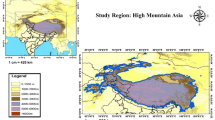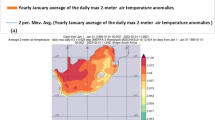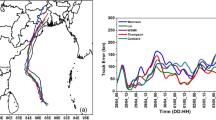Abstract
Anthropogenic climate change is expected to strengthen the vertical wind shears at aircraft cruising altitudes within the atmospheric jet streams. Such a strengthening would increase the prevalence of the shear instabilities that generate clear-air turbulence. Climate modelling studies have indicated that the amount of moderate-or-greater clear-air turbulence on transatlantic flight routes in winter will increase significantly in future as the climate changes. However, the individual responses of light, moderate, and severe clear-air turbulence have not previously been studied, despite their importance for aircraft operations. Here, we use climate model simulations to analyse the transatlantic wintertime clear-air turbulence response to climate change in five aviation-relevant turbulence strength categories. We find that the probability distributions for an ensemble of 21 clear-air turbulence diagnostics generally gain probability in their right-hand tails when the atmospheric carbon dioxide concentration is doubled. By converting the diagnostics into eddy dissipation rates, we find that the ensembleaverage airspace volume containing light clear-air turbulence increases by 59% (with an intra-ensemble range of 43%–68%), light-to-moderate by 75% (39%–96%), moderate by 94% (37%–118%), moderate-to-severe by 127% (30%–170%), and severe by 149% (36%–188%). These results suggest that the prevalence of transatlantic wintertime clear-air turbulence will increase significantly in all aviation-relevant strength categories as the climate changes.
Article PDF
Similar content being viewed by others
Avoid common mistakes on your manuscript.
References
Atlas, D., J. I. Metcalf, J. H. Richter, and E. E. Gossard, 1970: The birth of “CAT” and microscale turbulence. J. Atmos. Sci., 27, 903–913.
Brown, R., 1973: New indices to locate clear-air turbulence. Meteor. Mag., 102, 347–361.
Burbidge, R., 2016: Adapting European airports to a changing climate. Transportation Research Procedia, 14, 14–23.
Clark, T. L., W. D. Hall, R. M. Kerr, D. Middleton, L. Radke, F. M. Ralph, P. J. Neiman, and D. Levinson, 2000: Origins of aircraft-damaging clear-air turbulence during the 9 December 1992 Colorado downslope windstorm: Numerical simulations and comparison with observations. J. Atmos. Sci., 57, 1105–1131.
Coffel, E., and R. Horton, 2015: Climate change and the impact of extreme temperatures on aviation. Weather, Climate, and Society, 7, 94–102.
Colson, D., and H. A. Panofsky, 1965: An index of clear air turbulence. Quart. J. Roy. Meteor. Soc., 91, 507–513.
Delcambre, S. C., D. J. Lorenz, D. J. Vimont, and J. E. Martin, 2013: Diagnosing northern hemisphere jet portrayal in 17 CMIP3 global climate models: Twenty-first-century projections. J. Climate, 26, 4930–4946.
Ellrod, G. P., and D. I. Knapp, 1992: An objective clear-air turbulence forecasting technique: Verification and operational use. Wea. Forecasting, 7, 150–165.
Endlich, R. M., 1964: The mesoscale structure of some regions of clear-air turbulence. J. Atmos. Sci., 3, 261–276.
FAA, 2006: Preventing injuries caused by turbulence. Advisory Circular 120-88A, Federal Aviation Administration, Washington, DC.
Forster, P. M. de, and K. P. Shine, 2002: Assessing the climate impact of trends in stratospheric water vapor. Geophys. Res. Lett., 29, 1086.
Francis, J. A., and S. J. Vavrus, 2012: Evidence linking Arctic amplification to extreme weather in mid-latitudes. Geophys. Res. Lett., 39, L06801.
Frehlich, R., and R. Sharman, 2004: Estimates of turbulence from numerical weather prediction model output with applications to turbulence diagnosis and data assimilation. Mon.Wea. Rev., 132, 2308–2324.
Goessling, H. F., and S. Bathiany, 2016: Why CO2 cools the middle atmosphere—A consolidating model perspective. Earth System Dynamics, 7, 697–715.
CAO, 2015: International Civil Aviation Organization (ICAO) Second High-Level Safety Conference (HLSC), Montreal, Canada, 2–5 February 2015, Working Paper on Extreme Meteorological Conditions (HLSC/15-WP/36). [Available online from www.icao.int/ Meetings/HLSC2015/Documents/WP/wp036 en.pdf].
Irvine, E. A., B. J. Hoskins, K. P. Shine, R. W. Lunnon, and C. Froemming, 2013: Characterizing North Atlantic weather patterns for climate-optimal aircraft routing. Meteorological Applications, 20, 80–93.
Irvine, E. A., K. P. Shine, and M. A. Stringer, 2016: What are the implications of climate change for trans-Atlantic aircraft routing and flight time? Transportation Research Part D: Transport and Environment, 47, 44–53.
Jaeger, E. B., and M. Sprenger, 2007: A Northern Hemispheric climatology of indices for clear air turbulence in the tropopause region derived from ERA40 reanalysis data. J. Geophys. Res., 112(D20), D20106.
Karnauskas, K. B., J. P. Donnelly, H. C. Barkley, and J. E. Martin, 2015: Coupling between air travel and climate. Nature Clim. Change, 5, 1068–1073.
Karpechko, A., A. Lukyanov, E. Kyrö, S. Khaikin, L. Korshunov, R. Kivi, and H. Vömel, 2007: The water vapour distribution in the Arctic lowermost stratosphere during the LAUTLOS campaign and related transport processes including stratosphere–troposphere exchange. Atmos. Chem. Phys., 7, 107–119.
Kauffmann, P., 2002: The business case for turbulence sensing systems in the US air transport sector. Journal of Air Transport Management, 8, 99–107.
Kim, B., and Coauthors, 2005: System for assessing Aviation’s Global Emissions (SAGE), Version 1.5, Technical Manual FAA-EE-2005-01, Federal Aviation Administration, Washington, DC.
Kim, J.-H., and H.-Y. Chun, 2011: Statistics and possible sources of aviation turbulence over South Korea. J. Appl. Meteor. Climatol., 50, 311–324.
Kim, J.-H., W. N. Chan, B. Sridhar, R. D. Sharman, P. D. Williams, and M. Strahan, 2016: Impact of the North Atlantic Oscillation on transatlantic flight routes and clear-air turbulence. J. Appl. Meteor. Climatol., 55, 763–771.
Kim, S.-H., and H.-Y. Chun, 2016: Aviation turbulence encounters detected from aircraft observations: Spatiotemporal characteristics and application to Korean Aviation Turbulence Guidance. Meteorological Applications, 23, 594–604.
Knox, J. A., D. W. McCann, and P. D. Williams, 2008: Application of the Lighthill–Ford theory of spontaneous imbalance to clear-air turbulence forecasting. J. Atmos. Sci., 65, 3292–3304.
Krozel, J., V. Klimenko, and R. Sharman, 2011: Analysis of clear-air turbulence avoidance maneuvers. Air Traffic Control Quarterly, 19, 147–168.
Lane, T. P., R. D. Sharman, S. B. Trier, R. G. Fovell, and J. K. Williams, 2012: Recent advances in the understanding of near-cloud turbulence. Bull. Amer. Meteor. Soc., 93, 499–515.
Lee, D. S., D. W. Fahey, P. M. Forster, P. J. Newton, R. C. N. Wit, L. L. Lim, B. Owen, and R. Sausen, 2009: Aviation and global climate change in the 21st century. Atmos. Environ., 43, 3520–3537.
Lee, L., 2013: A climatological study of clear air turbulence over the North Atlantic. Master’s thesis, Dept. of Earth Sciences, Uppsala University.
Lilly, D. K., D. E. Waco, and S. I. Adelfang, 1974: Stratospheric mixing estimated from high-altitude turbulence measurements. J. Appl. Meteor., 13, 488–493.
Lorenz, D. J., and E. T. DeWeaver, 2007: Tropopause height and zonal wind response to global warming in the IPCC scenario integrations. J. Geophys. Res., 112, D10119.
MacCready, P. B., 1964: Standardization of gustiness values from aircraft. J. Appl. Meteor., 3, 439–449.
Malwitz, A., and Coauthors, 2005: System for assessing Aviation’s Global Emissions (SAGE), Version 1.5, Validation Assessment, Model Assumptions and Uncertainties. Tech. Rep. FAA-AA-EE-2005-03, Federal Aviation Administration, Washington, DC.
Maycock, A. C., M. M. Joshi, K. P. Shine, and A. A. Scaife, 2013: The circulation response to idealized changes in stratospheric water vapor. J. Climate, 26, 545–561.
McCann, D. W., J. A. Knox, and P. D. Williams, 2012: An improvement in clear-air turbulence forecasting based on spontaneous imbalance theory: The ULTURB algorithm. Meteorological Applications, 19, 71–78.
Meehl, G. A., and Coauthors, 2007: Global climate projections. Climate Change 2007: The Physical Science Basis. Contribution of Working Group I to the Fourth Assessment Report of the Intergovernmental Panel on Climate Change, Solomon et al., Eds., Cambridge University Press, 747–846.
Meneguz, E., H. Wells, and D. Turp, 2016: An automated system to quantify aircraft encounters with convectively induced turbulence over Europe and the Northeast Atlantic. J. Appl. Meteor. Climatol., 55, 1077–1089.
Penner, J. E., D. H. Lister, D. J. Griggs, D. J. Dokken, and M. Mc-Farland, 1999: Intergovernmental Panel on Climate Change (IPCC) special report: Aviation and the global atmosphere. Cambridge University Press, 373 pp.
Puempel, H., and P. D. Williams, 2016: The impacts of climate change on aviation: Scientific challenges and adaptation pathways. ICAO Environmental Report 2016: On Board A Sustainable Future, 205–207.
Reiter, E. R., 1963: Jet-stream Meteorology. University of Chicago Press, 515 pp.
Riddaway, R. W., 1998: Notes and news. Meteorological Applications, 5, 183–188.
Romps, D. M., J. T. Seeley, D. Vollaro, and J. Molinari, 2014: Projected increase in lightning strikes in the United States due to global warming. Science, 346, 851–854.
Schwartz, B., 1996: The quantitative use of PIREPs in developing aviation weather guidance products.Wea. Forecasting, 11, 372–384.
Shapiro, M. A., 1980: Turbulent mixing within tropopause folds as a mechanism for the exchange of chemical constituents between the stratosphere and troposphere. J. Atmos. Sci., 37, 994–1004.
Sharman, R., C. Tebaldi, G. Wiener, and J. Wolff, 2006: An integrated approach to mid-and upper-level turbulence forecasting. Wea. Forecasting, 21, 268–287.
Sharman, R. D., and J. M. Pearson, 2017: Prediction of energy dissipation rates for aviation turbulence. Part I: Forecasting nonconvective turbulence. J. Appl. Meteor. Climatol., 56, 317–337.
Sharman, R. D., S. B. Trier, T. P. Lane, and J. D. Doyle, 2012: Sources and dynamics of turbulence in the upper troposphere and lower stratosphere: A review. Geophys. Res. Lett., 39, L12803.
Sharman, R. D., L. B. Cornman, G. Meymaris, J. Pearson, and T. Farrar, 2014: Description and derived climatologies of automated in situ eddy-dissipation-rate reports of atmospheric turbulence. J. Appl. Meteor. Climatol., 53, 1416–1432.
Shine, K. P., and Coauthors, 2003: A comparison of modelsimulated trends in stratospheric temperatures. Quart. J. Roy. Meteor. Soc., 129, 1565–1588.
Simpson, I. R., 2016: Climate change predicted to lengthen transatlantic travel times. Environ. Res. Lett., 11, 031002.
Solomon, A., and L. M. Polvani, 2016: Highly significant responses to anthropogenic forcings of the midlatitude jet in the Southern Hemisphere. J. Climate, 29, 3463–3470.
Traub, M., and J. Lelieveld, 2003: Cross-tropopause transport over the eastern Mediterranean. J. Geophys. Res., 108, 4712.
Trier, S. B., and R. D. Sharman, 2016: Mechanisms influencing cirrus banding and aviation turbulence near a convectively enhanced upper-level jet stream. Mon. Wea. Rev., 144, 3003–3027.
Trier, S. B., R. D. Sharman, and T. P. Lane, 2012: Influences of moist convection on a cold-season outbreak of Clear-Air Turbulence (CAT). Mon. Wea. Rev., 140, 2477–2496.
Vallis, G. K., P. Zurita-Gotor, C. Cairns, and J. Kidston, 2015: Response of the large-scale structure of the atmosphere to global warming. Quart. J. Roy. Meteor. Soc., 141, 1479–1501.
Vrancken, P., and Coauthors, 2016: Flight tests of the DELICAT airborne LIDAR system for remote clear air turbulence detection. EPJ Web of Conferences, 119, 14003.
Warner, M., 2013: Boeing: Current market outlook 2013–2032. Boeing Commercial Airplanes, Seattle, WA.
Watkins, C. D., and K. A. Browning, 1973: The detection of clear air turbulence by radar. Physics in Technology, 4, 28–61.
Wilcox, L. J., K. P. Shine, and B. J. Hoskins, 2012: Radiative forcing due to aviation water vapour emissions. Atmos. Environ., 63, 1–13.
Wilkerson, J. T., M. Z. Jacobson, A. Malwitz, S. Balasubramanian, R. Wayson, G. Fleming, A. D. Naiman, and S. K. Lele, 2010: Analysis of emission data from global commercial aviation: 2004 and 2006. Atmos. Chem. Phys., 10, 6391–6408.
Williams, J. K., 2014: Using random forests to diagnose aviation turbulence. Machine Learning, 95, 51–70.
Williams, P. D., 2016: Transatlantic flight times and climate change. Environ. Res. Lett., 11, 024008.
Williams, P. D., and M. M. Joshi, 2013: Intensification of winter transatlantic aviation turbulence in response to climate change. Nature Clim. Change, 3, 644–648.
Williams, P. D., and M. M. Joshi, 2016: Clear-air turbulence in a changing climate. Aviation Turbulence: Processes, Detection, Prediction, R. Sharman and T. Lane, Eds., Springer International Publishing, 465–480.
Williams, P. D., P. L. Read, and T. W. N. Haine, 2003: Spontaneous generation and impact of inertia–gravity waves in a stratified, two-layer shear flow. Geophys. Res. Lett., 30, 2255.
Williams, P. D., T. W. N. Haine, and P. L. Read, 2005: On the generation mechanisms of short-scale unbalanced modes in rotating two-layer flows with vertical shear. J. Fluid Mech., 528, 1–22.
Williams, P. D., T. W. N. Haine, and P. L. Read, 2008: Inertia–gravity waves emitted from balanced flow: Observations, properties, and consequences. J. Atmos. Sci., 65, 3543–3556.
Wolff, J. K., and R. D. Sharman, 2008: Climatology of upper-level turbulence over the contiguous United States. J. Appl. Meteor. Climatol., 47, 2198–2214.
Acknowledgements
The author is financially supported through a University Research Fellowship from the Royal Society (reference UF130571). He thanks Jenny LIN for her invitation and encouragement to write an article on aviation turbulence. The author acknowledges the modelling groups, the Program for Climate Model Diagnosis and Intercomparison, and the World Climate Research Programme’sWorking Group on Coupled Modelling for their roles in making available the climate model data. Support of this dataset is provided by the Office of Science, US Department of Energy. The constructive comments of four reviewers are gratefully acknowledged.
Author information
Authors and Affiliations
Corresponding author
Additional information
This article is published with open access at link.springer.com.
Rights and permissions
Open Access This article is distributed under the terms of the Creative Commons Attribution 4.0 International License (http://creativecommons.org/licenses/by/4.0/), which permits unrestricted use, distribution, and reproduction in any medium, provided you give appropriate credit to the original author(s) and the source, provide a link to the Creative Commons license, and indicate if changes were made.
About this article
Cite this article
Williams, P.D. Increased light, moderate, and severe clear-air turbulence in response to climate change. Adv. Atmos. Sci. 34, 576–586 (2017). https://doi.org/10.1007/s00376-017-6268-2
Received:
Revised:
Accepted:
Published:
Issue Date:
DOI: https://doi.org/10.1007/s00376-017-6268-2




